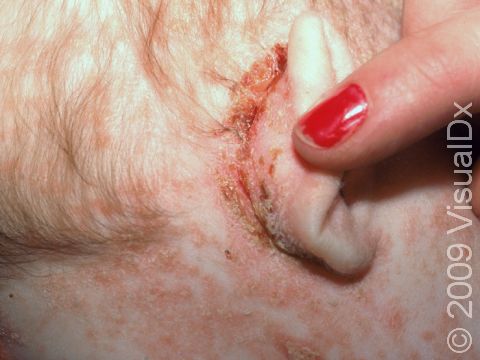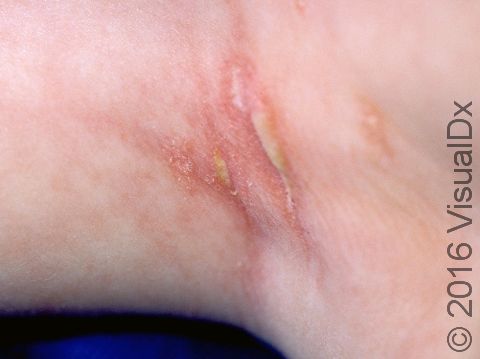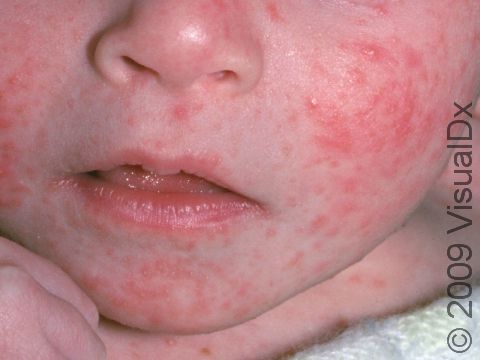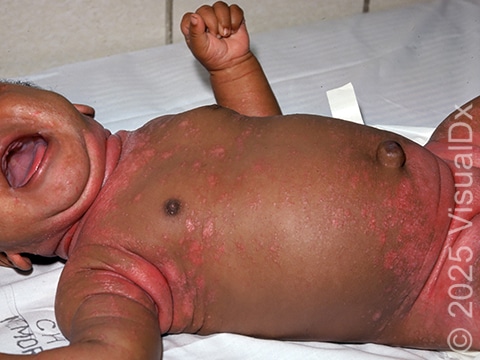Seborrheic Dermatitis (Pediatric)
Seborrheic dermatitis in infants is a common condition of skin areas rich in oil glands (including the face, scalp, and upper trunk). Overproduction of skin cells leads to flaking and sometimes inflammation, with color changes to the skin and itching. In lighter skin colors, the affected area may be pink or red. In darker skin colors, the affected area may be pinkish, purplish, dark brown, or gray, or some of the patches might look lighter in color (hypopigmented).
Seborrheic dermatitis varies in severity from mild dandruff of the scalp to scaly patches on the skin. The normal skin yeast Pityrosporum ovale lives in oil-rich skin regions and plays a role in this disorder.
Cradle cap is the common name for seborrheic dermatitis affecting the scalp of newborns. It is often seen in babies up to age 3 months. The skin becomes flaky and inflamed, sometimes with a yellowish scale. If the scale is picked off, the skin underneath will look pink, red, or dark brown. Cradle cap is not serious, but the areas can become infected if not treated properly.
Any baby can develop cradle cap. It is not contagious and does not occur because of poor hygiene.
Who's At Risk?
- Seborrheic dermatitis is most often seen in newborns and infants up to age 6 months.
- Seborrheic dermatitis typically resolves by age 6-12 months.
- Severe seborrheic dermatitis may be associated with a disease that causes a lowered immune system (immunodeficiency).
Signs & Symptoms
In newborns and infants, seborrheic dermatitis is seen on the scalp (most commonly known as cradle cap) and body folds.
- The scalp is itchy and sheds white, oily skin flakes. When severe, the scalp can have thick, yellow scale and crust.
- One or more of the following areas has patches of red, purplish, brown, gray, or whitish scaly skin: the scalp, hairline, forehead, eyebrows, eyelids, creases of the nose and ears, ear canals, breastbone, midback, groin, and underarms.
- In people with darker skin, some of the patches might look lighter in color (hypopigmented).
The condition may be:
- Mild – only some flaking and skin color change (as outlined above) in a few small areas.
- Moderate – several areas affected with bothersome skin color change and itch.
- Severe – large areas of skin color change, severe itch, and shampoos do not reduce scales.
The condition may be:
- Mild – only some flaking and redness in a few small areas.
- Moderate – several areas affected with bothersome redness and itch.
- Severe – large areas of redness, severe itch, and unresponsive to self-care measures.
Self-Care Guidelines
Scales on the scalp can be removed. Apply warm oil (be careful not to apply oil that is too hot for your baby’s skin) to the scalp for a few hours. Before bathing your baby, gently rub their scalp with a soft bristle baby brush, and then wash the hair with a gentle shampoo (eg, Johnson’s Baby Shampoo) or an over-the-counter antidandruff shampoo, such as a shampoo containing 2% zinc pyrithione (Head & Shoulders). Be careful not to get medicated shampoo in the baby’s eyes.
Some over-the-counter creams will help if the medicated shampoo is not working well enough. These are often added to the shampoo until you notice improvement. You can stop using them and then start using them again temporarily as needed. These include:
- Creams that reduce the Pityrosporum yeast (clotrimazole [Lotrimin], miconazole [Monistat]).
- Hydrocortisone (Cortaid) cream.
Treatments
Your child’s medical professional may recommend a prescription shampoo. If your baby’s skin is very inflamed, they may prescribe a mild corticosteroid cream or solution. If your baby has a skin infection, they will prescribe antibiotics.
Visit Urgency
See your child’s medical professional or a dermatologist if there is no response to self-care measures.
Also call your child’s medical professional if the seborrheic dermatitis looks inflamed and oozes or if your baby has a fever. These could be signs of an infection.
Trusted Links
References
Bolognia J, Schaffer JV, Cerroni L. Dermatology. 4th ed. Philadelphia, PA: Elsevier; 2018.
James WD, Elston D, Treat JR, Rosenbach MA. Andrew’s Diseases of the Skin. 13th ed. Philadelphia, PA: Elsevier; 2019.
Kang S, Amagai M, Bruckner AL, et al. Fitzpatrick’s Dermatology. 9th ed. New York, NY: McGraw-Hill Education; 2019.
Paller A, Mancini A. Paller and Mancini: Hurwitz Clinical Pediatric Dermatology. 6th ed. St. Louis, MO: Elsevier; 2022.
Last modified on July 11th, 2025 at 11:03 am

Not sure what to look for?
Try our new Rash and Skin Condition Finder








